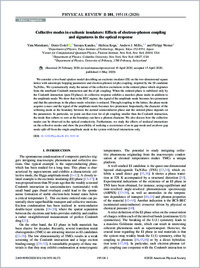Collective modes in excitonic insulators: Effects of electron-phonon coupling and signatures in the optical response
- Murakami, Yuta Department of Physics, Tokyo Institute of Technology, Meguro, Tokyo 152-8551, Japan
- Golež, Denis Center for Computational Quantum Physics, Flatiron Institute, New York, New York 10010, USA
- Kaneko, Tatsuya Department of Physics, Columbia University, New York, New York 10027, USA
- Koga, Akihisa Department of Physics, Tokyo Institute of Technology, Meguro, Tokyo 152-8551, Japan
- Millis, Andrew J. Center for Computational Quantum Physics, Flatiron Institute, New York, New York 10010, USA - Department of Physics, Columbia University, New York, New York 10027, USA
- Werner, Philipp Department of Physics, University of Fribourg, 1700 Fribourg, Switzerland
-
11.05.2020
Published in:
- Physical Review B. - 2020, vol. 101, no. 19, p. 195118
English
We consider a two-band spinless model describing an excitonic insulator (EI) on the two-dimensional square lattice with anisotropic hopping parameters and electron-phonon (el-ph) coupling, inspired by the EI candidate Ta2NiSe5. We systematically study the nature of the collective excitations in the ordered phase which originates from the interband Coulomb interaction and the el-ph coupling. When the ordered phase is stabilized only by the Coulomb interaction (pure EI phase), its collective response exhibits a massless phase mode in addition to the amplitude mode. We show that in the BEC regime, the signal of the amplitude mode becomes less prominent and that the anisotropy in the phase- mode velocities is reduced. Through coupling to the lattice, the phase mode acquires a mass and the signal of the amplitude mode becomes less prominent. Importantly, the character of the softening mode at the boundary between the normal semiconductor phase and the ordered phase depends on the parameters. In particular, we point out that even for el-ph coupling smaller than the Coulomb interaction, the mode that softens to zero at the boundary can have a phonon character. We also discuss how the collective modes can be observed in the optical conductivity. Furthermore, we study the effects of nonlocal interactions on the collective modes and show the possibility of realizing a coexistence of an in-gap mode and an above-gap mode split off from the single-amplitude mode in the system with local interactions only.
- Faculty
- Faculté des sciences et de médecine
- Department
- Département de Physique
- Language
-
- English
- Classification
- Physics
- License
-
License undefined
- Identifiers
-
- RERO DOC 328544
- DOI 10.1103/PhysRevB.101.195118
- Persistent URL
- https://folia.unifr.ch/unifr/documents/308576
Statistics
Document views: 102
File downloads:
- pdf: 328
